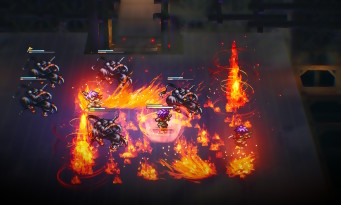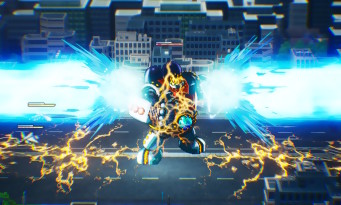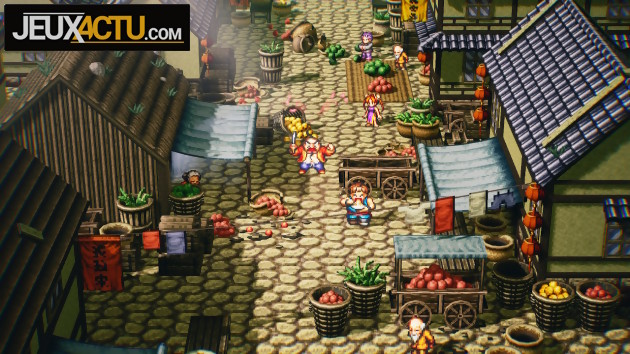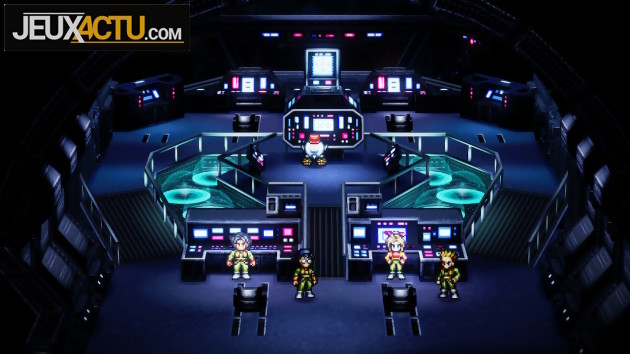If the evocation of the scenario is generally a required passage for the analysis of an RPG, it would be quite difficult to follow this tradition here since Live A Live consists of seven small independent adventures. At least, in appearance. Because after having completed these chapters with unique heroes and time periods, two new playable sections linking the various elements are unlocked. Since it is impossible to approach this point without spoiler, we will content ourselves with telling you that the whole is not lacking in interest and that things are not necessarily as manichean and disjointed as they seem. At first sight. Regarding the gameplay, the common point between the different chapters lies in the clashes. We are dealing with a J-RPG from 1994, and it is therefore a turn-based combat system. But this one has the particularity of ignoring mana management, time acting as the main “resource”. Concretely, each hero or enemy has a charge gauge that determines who attacks when. The most powerful spells obviously require more preparation time, while moving one space on the squared terrain immediately increases the gauge of all the other characters. This point is all the more important since the areas of effect differ completely from one attack to another (single square, diagonal, “full” rectangle centered on the fighter, “hollow” rectangle, crooked geometric pattern, etc. ). As a player, you must therefore constantly weigh the pros and cons, between moving to optimize our attacks, moving to avoid enemy blows, or staying in place so as not to accelerate the charge of the opposing gauges. This very pleasant system still suffers from an approximate balancing, which allows you to get out of most situations by constantly spamming the same action. An option “hold the cursor” is also available so that the previous choice is automatically preselected in the next turn. Fortunately, the wide variety of eras largely compensates for this aspect, which otherwise could have been a little too boring.
EPIC TIMES
 If we won’t say a word about the final two chapters to unlock, the first seven are Prehistory, Imperial China, End of Edo Japan, Wild West, Present, Near Future and Far Future. We’ve listed them here in chronological order, but you can browse them in any order you want. They’re all freely accessible from a circular menu, and none spoil another. This freedom is welcome, but it is above all the variety of situations and environments that constitutes the major quality of the adventure. Especially since the developers didn’t just change locations, heroes, and eras. Each chapter has its own rhythm, and often a small “twist” of gameplay. In prehistory, for example, icons came to replace the lines of dialogue, the descriptions of the objects used a deliberately summary language, and the attacks were called “Fé dodo”, “Pé kipu” or “Lans’ caca”. The hunter hero can use his sense of smell to make small clouds of dust appear in the scenery, which he must then follow to come across a random fight (which isn’t so much anymore). The chapter of Imperial China is more classic, a little too much even since it focuses on the training of three disciples by an old Chinese master, which gives rise to repetitive fights. Let’s move on.
If we won’t say a word about the final two chapters to unlock, the first seven are Prehistory, Imperial China, End of Edo Japan, Wild West, Present, Near Future and Far Future. We’ve listed them here in chronological order, but you can browse them in any order you want. They’re all freely accessible from a circular menu, and none spoil another. This freedom is welcome, but it is above all the variety of situations and environments that constitutes the major quality of the adventure. Especially since the developers didn’t just change locations, heroes, and eras. Each chapter has its own rhythm, and often a small “twist” of gameplay. In prehistory, for example, icons came to replace the lines of dialogue, the descriptions of the objects used a deliberately summary language, and the attacks were called “Fé dodo”, “Pé kipu” or “Lans’ caca”. The hunter hero can use his sense of smell to make small clouds of dust appear in the scenery, which he must then follow to come across a random fight (which isn’t so much anymore). The chapter of Imperial China is more classic, a little too much even since it focuses on the training of three disciples by an old Chinese master, which gives rise to repetitive fights. Let’s move on.
Especially since the developers didn’t just change locations, heroes, and eras. Each chapter has its own rhythm, and often a small “twist” of gameplay.
 Edo’s End of Japan is a much more unique adventure as it introduces infiltration mechanics as well as a labyrinthine castle filled with traps and secret passages. The shinobi that we embody can become invisible at will, just to avoid certain fights if he wishes. While the intention is laudable, the functionality and balance of this feature leaves something to be desired. You have to wait far too long seconds for the guards to pass, while the lack of experience gain makes some later fights extremely difficult. Our advice: kill everyone! The Wild West has a nice cinematic atmosphere and asks us to find objects in the sets, then give them to certain inhabitants so that they lay traps to survive a final attack. The Present takes the form of a simple succession of fights that parodies fighting games (including in the opponent selection menu), while our hero can only learn new attacks by undergoing them for the first time. Short, but very funny. The Near Future is also entitled to a very nice presentation, thanks in particular to a credits which parodies the series of Grendizer types. In addition, the character you control has the ability to read the minds of the NPCs he questions. Finally, the Distant Future offers an atmosphere halfway between Alien and 2001, a Space Odyssey. Extremely narrative, this chapter imposes no confrontation apart from the final boss. An optional and fictitious arcade terminal (“Captain Square”) is still available to find the game’s combat system for a few minutes.
Edo’s End of Japan is a much more unique adventure as it introduces infiltration mechanics as well as a labyrinthine castle filled with traps and secret passages. The shinobi that we embody can become invisible at will, just to avoid certain fights if he wishes. While the intention is laudable, the functionality and balance of this feature leaves something to be desired. You have to wait far too long seconds for the guards to pass, while the lack of experience gain makes some later fights extremely difficult. Our advice: kill everyone! The Wild West has a nice cinematic atmosphere and asks us to find objects in the sets, then give them to certain inhabitants so that they lay traps to survive a final attack. The Present takes the form of a simple succession of fights that parodies fighting games (including in the opponent selection menu), while our hero can only learn new attacks by undergoing them for the first time. Short, but very funny. The Near Future is also entitled to a very nice presentation, thanks in particular to a credits which parodies the series of Grendizer types. In addition, the character you control has the ability to read the minds of the NPCs he questions. Finally, the Distant Future offers an atmosphere halfway between Alien and 2001, a Space Odyssey. Extremely narrative, this chapter imposes no confrontation apart from the final boss. An optional and fictitious arcade terminal (“Captain Square”) is still available to find the game’s combat system for a few minutes.
MORE ALIVE THAN EVER
 The variety of situations, which is clearly the specificity of Live A Live, has therefore come down to us intact since 1994. There are also a few flaws, it must be admitted. Whether it’s the balancing of the fights (sometimes you have to “grind”) or the lack of clarity of certain objectives, we feel that the adventure dates from the last century. A radar indicating the direction of the next place of interest is still available. It is really welcome, even if it does not always prevent getting lost (especially in the chapter The End of Edo’s Japan). Moreover, this remake has the good taste to offer us both Japanese voices and English voices, while the French texts benefit from a quality translation. But obviously, it’s the graphic overhaul that remains the star of the show. Square Enix chose to use the HD-2D processing already seen in Octopath Traveler and Triangle Strategy. If this system mixing pixelated 2D characters and 3D scenery was already very appreciable in these two titles, it is particularly relevant here. The lighting effects and camera movements bring the necessary touch of modernity, while the retro aspect recalls the adventure of yesteryear. Unlike a total 3D redesign, the game remains faithful to our period memories and leaves intact the part of imagination specific to each player, who can thus mentally “complete” the lack of detail of the sprites as he sees fit. This avoids ending up with magnificent 3D characters but which do not correspond to the idea we had of them. On this point the success is such that it seems obvious that this HD-2D technique will be reused by the editor for other remakes in the future. Only Dragon Quest III HD-2D Remake has been announced so far, but more will surely follow. We also find ourselves dreaming of an HD-2D compilation of the first six episodes of Final Fantasy… Let’s end with a last positive note about Live A Live: the music is always pleasant to the ear, and judiciously adapted to the context history of each chapter!
The variety of situations, which is clearly the specificity of Live A Live, has therefore come down to us intact since 1994. There are also a few flaws, it must be admitted. Whether it’s the balancing of the fights (sometimes you have to “grind”) or the lack of clarity of certain objectives, we feel that the adventure dates from the last century. A radar indicating the direction of the next place of interest is still available. It is really welcome, even if it does not always prevent getting lost (especially in the chapter The End of Edo’s Japan). Moreover, this remake has the good taste to offer us both Japanese voices and English voices, while the French texts benefit from a quality translation. But obviously, it’s the graphic overhaul that remains the star of the show. Square Enix chose to use the HD-2D processing already seen in Octopath Traveler and Triangle Strategy. If this system mixing pixelated 2D characters and 3D scenery was already very appreciable in these two titles, it is particularly relevant here. The lighting effects and camera movements bring the necessary touch of modernity, while the retro aspect recalls the adventure of yesteryear. Unlike a total 3D redesign, the game remains faithful to our period memories and leaves intact the part of imagination specific to each player, who can thus mentally “complete” the lack of detail of the sprites as he sees fit. This avoids ending up with magnificent 3D characters but which do not correspond to the idea we had of them. On this point the success is such that it seems obvious that this HD-2D technique will be reused by the editor for other remakes in the future. Only Dragon Quest III HD-2D Remake has been announced so far, but more will surely follow. We also find ourselves dreaming of an HD-2D compilation of the first six episodes of Final Fantasy… Let’s end with a last positive note about Live A Live: the music is always pleasant to the ear, and judiciously adapted to the context history of each chapter!
.
The post return to life of an RPG classic via a successful remake appeared first on Gamingsym.



